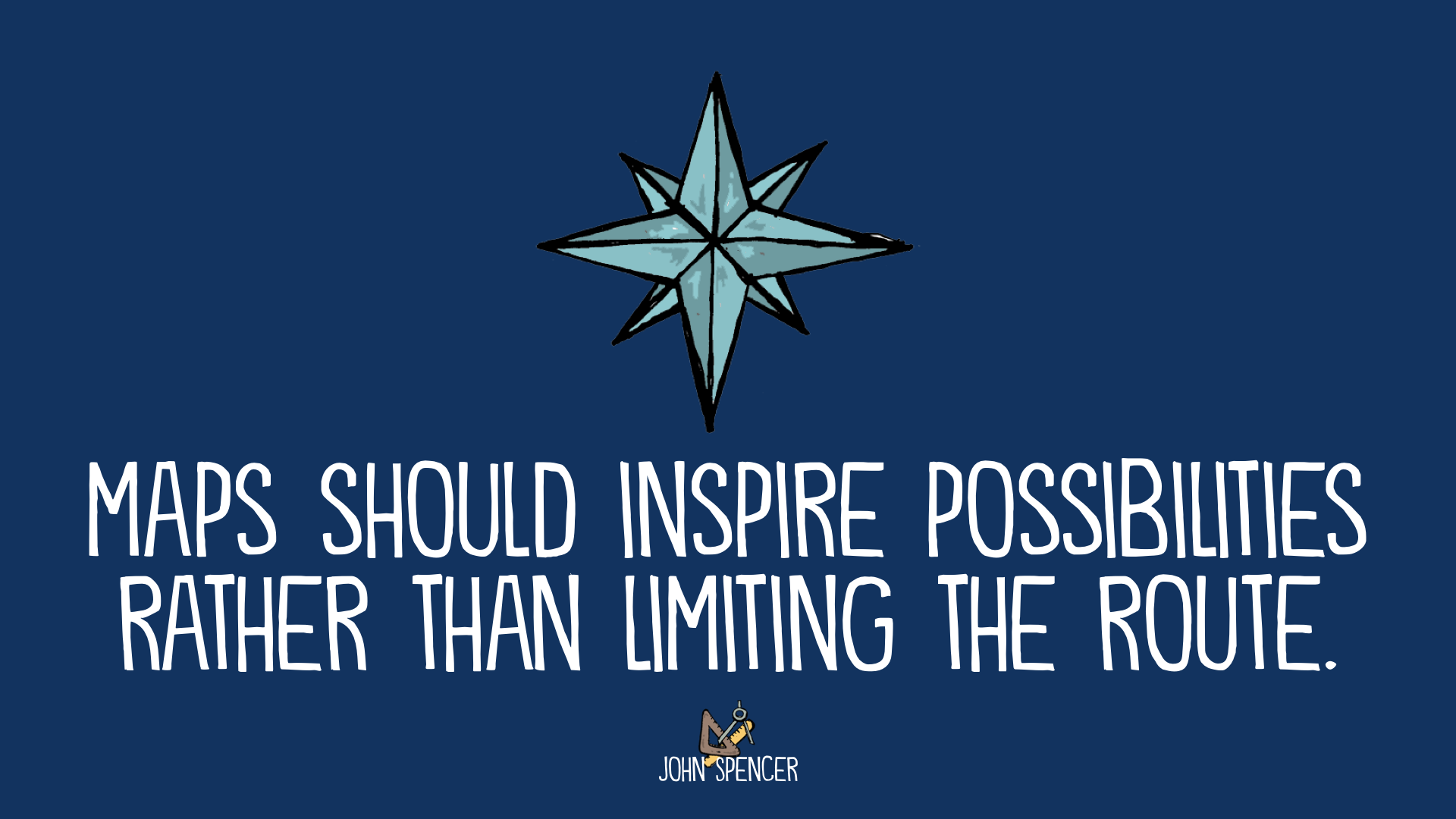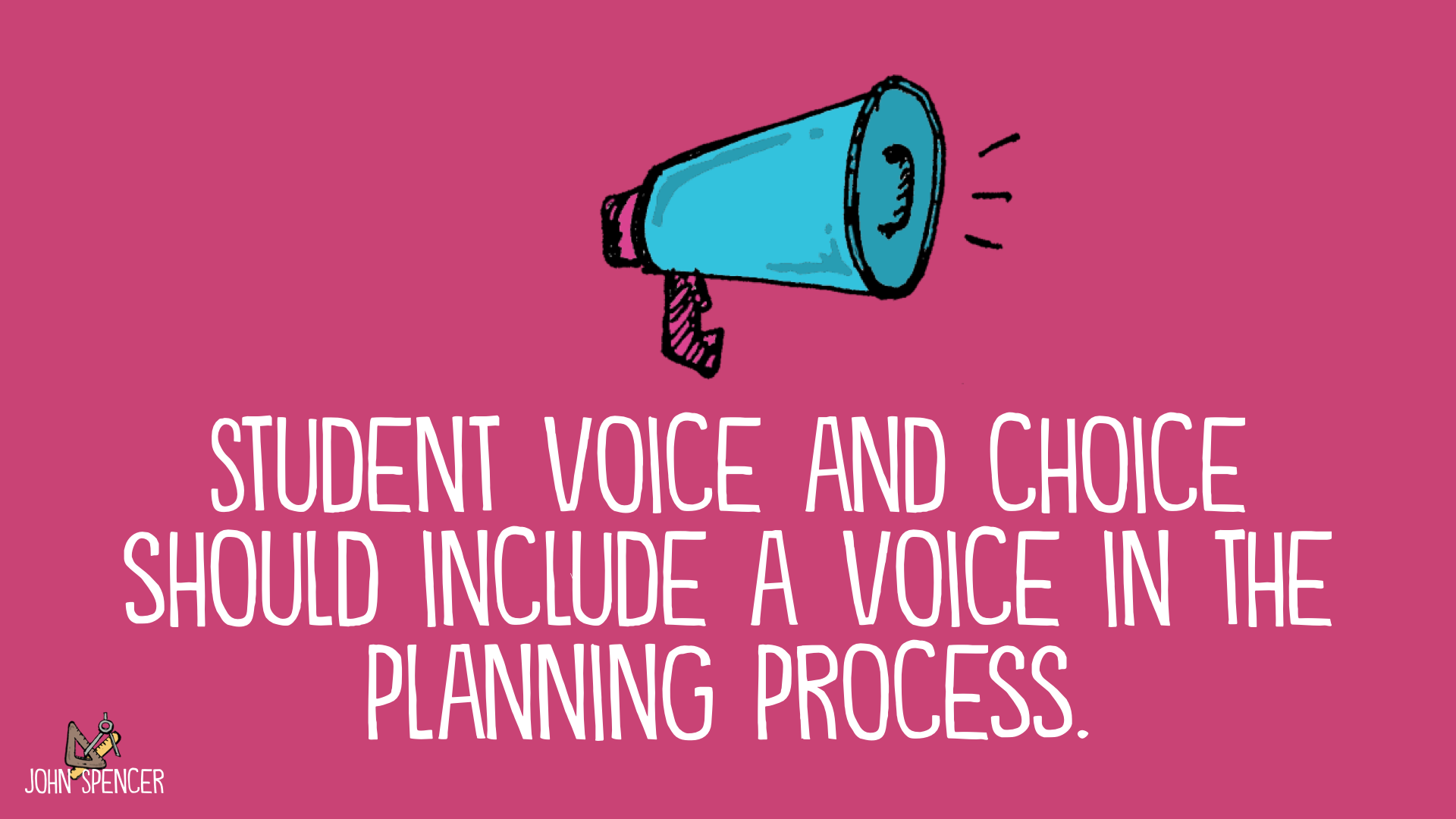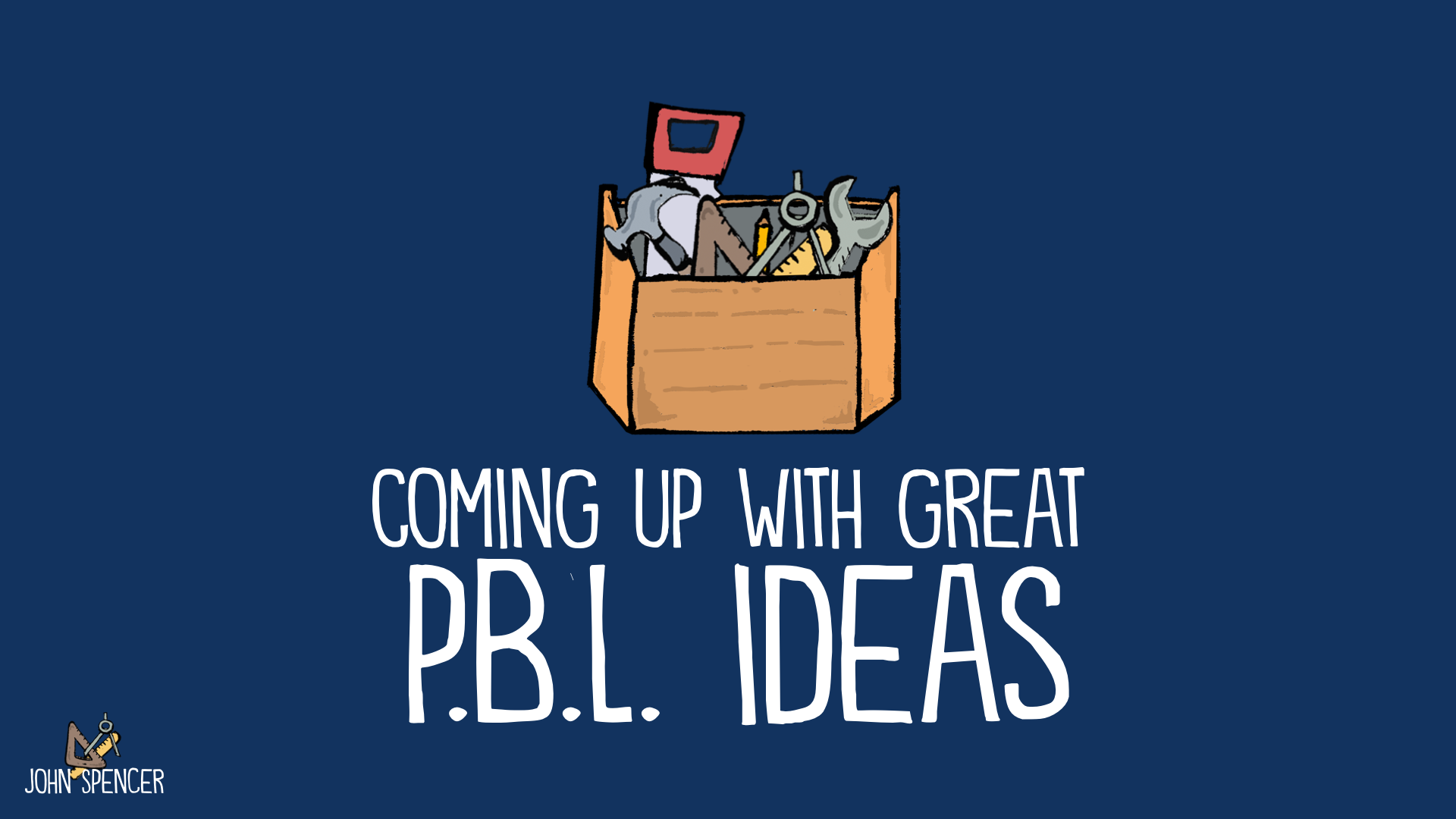How do you come up with great project ideas? (3 Starting Places)
Education Rethink 2022-03-14
I love to come up with project ideas. The brainstorming process feels a bit like going to a candy store, where I get to peruse past experiences, seek out new interests, find materials, and feel inspired by whatever pops up. Or better yet, it’s more like being a chef with a giant pantry full of ingredients. I can pick various spices here and a random ingredient there and then I get to fuse them together to create a new dish. Or perhaps it’s a bit like being an explorer. Yes, I have the constraint of a curriculum map but this map should inspire possibilities rather than limit my route. I get to explore and find new possibilities.
 In fact, the very constraints involved in having standards become a chance to “think inside the box.” I get to problem-solve and think strategically.
In fact, the very constraints involved in having standards become a chance to “think inside the box.” I get to problem-solve and think strategically.
{"@context":"http:\/\/schema.org\/","@id":"https:\/\/spencerauthor.com\/pbl-ideas\/#arve-youtube-lgyjgwsqxpg622fe28164c58716018214","type":"VideoObject","embedURL":"https:\/\/www.youtube-nocookie.com\/embed\/lGyjGwSQXpg?feature=oembed&iv_load_policy=3&modestbranding=1&rel=0&autohide=1&playsinline=0&autoplay=0"}
While I love coming up with PBL ideas, there’s a dark side to this. They tend to be my ideas, which means I’m likely to choose ideas and topics that I’m interested in or ideas that I think students will like. Whether it’s at the higher education level (where I currently teach) or at the middle school level (where I used to teach), I have to force myself to listen to others. This includes the larger community, the educators I work with, and the students I teach. I need to listen to what they want.
On the other hand, some people struggle to come up with new ideas. Over the last decade, I’ve had the honor of leading PBL workshops with teachers all over the world. I’ve done coaching with teachers in elite private schools and low-income Title One schools (like the type where I used to work). I’ve been in rural settings and worked with teachers in the heart of a city. For all the differences, I am struck by how similar our concerns and challenges tend to be. One of the most common questions I’ve heard is, “How do I come up with good project ideas?”
In this week’s article, I’m going to share some practical strategies for generating quality PBL ideas. But first, let’s explore what it means to design PBL experiences that actually work.
Listen to the Podcast
If you enjoy this blog but you’d like to listen to it on the go, just click on the audio below or subscribe via Apple Podcasts (ideal for iOS users) or Google Play and Stitcher (ideal for Android users).
https://spencerauthor.com/wp-content/uploads/2022/03/Coming-Up-with-PBL-Ideas.mp3
What Makes a Project Work?
It is amazing when projects work. This learning tends to stick because they are able to reduce the cognitive load by working with the information, thereby moving more knowledge from short-term to long-term memory. In turn, this knowledge sticks and we often see an increase in student achievement. But more importantly, students are empowered with more agency and self-direction. They gain critical soft skills as they engage in deeper learning. By empowering students in the present, we prepare them for the future.
{"@context":"http:\/\/schema.org\/","@id":"https:\/\/spencerauthor.com\/pbl-ideas\/#arve-youtube-6jrjisrhpek622fe28165669536455469","type":"VideoObject","embedURL":"https:\/\/www.youtube-nocookie.com\/embed\/6JrjiSRhPEk?feature=oembed&iv_load_policy=3&modestbranding=1&rel=0&autohide=1&playsinline=0&autoplay=0"}
And yet, not every project is guaranteed to succeed. We’ve all been there before. You plan out a project that you think students will love but two days into it you realize that it’s a dud. It simply isn’t working. The bad news is that you’ll never be able to avoid this scenario entirely. Teaching is messy and unpredictable and every project is an experiment. The good news is we think intentionally about our projects at the early stages when we first come up with a PBL concept.
Great student project ideas tend to be:
- Authentic: The best projects feel real to students. Often, these projects connect to an authentic audience and students use the same types of skills that people outside the classroom use as they work on projects. So, an entrepreneurial project in an economics class will include a business plan, market research, and product prototyping in a way that resembles a real business. By contrast, the worst projects I ever did as a classroom teacher were the ones that weren’t rooted in a real context. Jennifer Gonzalez refers to these as Grecian Urn Projects. These are the tasks that felt artificial and resembled pseudo-context. I remember designing a Civil Rights museum project where the end result was a website and a blueprint of a museum. It tanked. Students simply didn’t care because it wasn’t real to them. The next year, I redesigned this project as a real Civil Rights museum. The class had to coordinate together on a larger blueprint (the cafeteria) and each group designed interactive exhibits that the community could experience on a community night.
- Aligned to the Standards: Going PBL doesn’t mean we abandon the standards. It’s why I recently sent an email about the notion of aligning PBL to the standards. It’s an idea I explore in-depth in the PBL Master Course (where I walk you through the PBL planning process from generating an idea through designing an entire unit plan). When we don’t align PBL to the standards, students miss key concepts and skills and we’re likely to see a dip in student achievement. However, when when the project aligns well to the standards, students master the standards at a deeper level and the learning sticks. For a deeper dive, check out this article I wrote about how to align PBL to content standards.
- Feasible: Sometimes we have great ideas but we lack the time, materials, and expertise to pull it off. This is why we need to ask the question, “Is this actually realistic for us? Can we actually pull this off?” Sometimes these limitations can lead to bigger innovations and more creativity in our planning. At times, the very constraints we face become our best project design features. However, we need to acknowledge the challenges as we plan feasible projects.
- Challenging: The best projects inspire deep critical thinking and stretch students to develop vital soft skills. They inspire students to work harder to master the content. Some of the best projects I’ve done with students were the ones where they began by saying, “I don’t know if I can do this.” I think about our NaNoWriMo project where students weren’t sure they could write a novel in a month but each student ended up meeting the word count (which I set at a lower level of 30,000 words). Note that we still need to provide structures and scaffolds for students to succeed in a challenging project. Next week, I’ll be sharing strategies and tools to help ELL students and exceptional learners to succeed in high-challenge PBL experiences.
This sounds great but where do we actually go for project ideas? There are three main avenues for generating new PBL ideas.
Three Starting Places for PBL Ideas
Here are a few places to start as you brainstorm ideas for project-based learning.
1. Connect with a PBL Teacher Community
George Couros once shared the idea that “the smartest person in the room is the room.” This is the notion that our collective network of knowledge is greater than what each of us individually can come up with on our own. It’s an idea that James Surowiecki explored in Wisdom of the Crowds. This network of knowledge not only allows us to see more ideas but the process of interacting with others inspires new ideas as well.
This is why some of the greatest project ideas occur as you interact with a PBL community. You might join a private PBL Facebook group or connect with a PBL organization and do meet-ups or conferences. This is also why I included a community / discussion component to the PBL Master Course. It doesn’t have to be an online community. You might have a local meet up with other teachers who are in different stages of the PBL journey. You might attend a project-based learning conference. Sometimes we find ourselves hitting a mental block and we simply need exposure to more diverse ideas from people outside of our content, subject area, or school district.
At some point, though, it helps to have a community of fellow teachers who are also doing project-based learning together. PBL is a different approach to teaching and it can feel lonely to take a different route. You run into uncertainty and moments of frustration when nothing seems to work. In these moments, it helps to connect with other teachers who are also engaging in project-based learning. It’s a chance to take ownership in your professional development.
{"@context":"http:\/\/schema.org\/","@id":"https:\/\/spencerauthor.com\/pbl-ideas\/#arve-youtube-pw53uredr5u622fe2816607b441725427","type":"VideoObject","embedURL":"https:\/\/www.youtube-nocookie.com\/embed\/pw53uRedr5U?start=9&feature=oembed&iv_load_policy=3&modestbranding=1&rel=0&autohide=1&playsinline=0&autoplay=0"}
You might observe one another’s classes. You might start a mastermind group where you share your goals, your experiences, and problem-solve together. You might do a shared book study or go through a self-paced online course together. Through this process, you become inspired to try new ideas. You might co-plan entire units together with other teachers but you might borrow concepts from things you observe. We tend to think of inspiration as an individual, personal experience. And sometimes it is. But it’s also deeply social and tied to our community.
This community doesn’t have to be limited to fellow teachers. It might include industry experts.
2. Talk to Industry Experts
Years ago, I made a quip a barbecue that “nobody actually uses a matrix in real life.” I had been talking to a neighbor about how confusing upper level math was for me when I was in high school. Right then, a woman walked up to me and said, “I don’t mean to intrude but matrices are a huge part of what I do every day.” She then described how she used matrices in her field of engineering but then described how matrices were vital for everything from satellites to communications to social science data analysis to computer graphics and animation.
Similarly, I didn’t understand the value of Trigonometry until, as a history major, I learned about how ancient mathematicians used trigonometry to determine the distance of the earth to both the moon and the sun. Suddenly, math shifted from a series of formulas, recipes, and abstract ideas and toward a new way of thinking. It was a powerful way to solve real problems.
In both of these cases, I failed to grasp the authentic context of mathematics. Now, any time I find myself thinking, “We don’t use this content in the real world,” it’s almost always a chance for me to ask, “How do people actually use this in the real world?” It’s an opportunity to see how content connects to context.
One of my favorite ways to discover projects ideas is by interviewing industry experts who can tell me how they use the content in their context. As teachers, we can start with the content we teach and ask people, “What does this look like in your work?” We might interview an engineer before a STEM project or a community organizer before a social studies project. We might be content and pedagogy experts but often people in the field are experts in the context and application of that knowledge.
Another option is to connect students to industry experts so that they make a bridge between the content and the context. Which leads to my final idea . . .
3. Ask the Students
Some of my favorite project ideas have come from students. When we ask students for ideas, we build ownership into the process and we tap into student agency. Instead of trying to figure out what they’ll find authentic, we start with the question, “What do you find authentic?” and we listen intently at their answers. This doesn’t mean we simply let students decide every project. As educators, we are still the experts. However, it does mean we listen intently and humbly. We can honor student agency by bringing students into the planning and decision-making process.
 One way to do this is with optional student leadership teams. Think of it as a planning session with your students rather than your colleagues. The process is entirely democratic. Any student is welcome in the leadership team meetings and every student has an equal voice. In some cases, you might even invite a single student from each meeting to attend departmental or team planning sessions.
One way to do this is with optional student leadership teams. Think of it as a planning session with your students rather than your colleagues. The process is entirely democratic. Any student is welcome in the leadership team meetings and every student has an equal voice. In some cases, you might even invite a single student from each meeting to attend departmental or team planning sessions.
These meetings can take place before or after school or during a prep period. However, if you have time for it, you can invite the entire class to participate in this type of meeting once or twice a month. I first began using Student Leadership Meetings as a middle school team leader. We had launched a PBL program that blended together service learning, STEM, and multimedia creation. While the projects worked well, one team member asked, “If we really want student voice and choice, why are we coming up with the project ideas and the essential questions?” From here, we launched the Student Leadership team. At first, we had students apply to be on the team but we found that our most eager high achievers showed up but our less engaged students weren’t interested in the application process. Moreover, we didn’t have any a fair representation of exceptional learners or English Language Learners. So, we shifted toward a more democratic meeting.
Here’s how it works.
Student Leadership Team
Description:
Collectively, we can honor student agency by bringing students into the planning and decision-making process. One way to do this is with optional student leadership teams. Think of it as a planning session with your students rather than your colleagues. The process is entirely democratic. Any student is welcome in the leadership team meetings and every student has an equal voice. In some cases, you might even invite a single student from each meeting to attend departmental or team planning sessions. These meetings can take place before or after school or during a prep period. However, if you have time for it, you can invite the entire class to participate in this type of meeting once or twice a month. Our Student Leadership Team meetings occurred at lunch time once a week. We rotated which teacher ran the meeting and then that teacher took their lunch during the prep time instead.
Agenda
Part 1: Check-In
- Quick individual check-in: Each student says one high, one low, and one random fact about themselves.
Part 2: Current Feedback
- Open feedback on what is going well in the current projects: You might ask specific questions about policies, practices, or lessons. For example, “What is going well with student collaboration?” or “What was your favorite mini-project?” Or, you can keep it open-ended with a question like, “What has been your favorite part of the course so far?”
- Open feedback on what could be improved: Again, this might be specific, with a question like, “How can we improve the course design?” or “What would you have changed about our last virtual meeting?”
Part 3: Decision-Making
This varies from week to week, but here are some basic ideas of what you might do:
Generating Ideas
- Set the stage: Explain what the upcoming unit(s) will be. You might need to begin by showing them the curriculum map and having students look at the standards, skills, and topics.
- Research ideas: Give students the chance to look online for examples of projects that align to the curriculum.
- Share ideas: In this phase, each group member shares project ideas that they have. To avoid judgment, you might just solicit ideas without getting feedback.
Narrowing Down
- Ask for feedback on an idea: Here, you might share an idea of something you would like to try with your students. It’s also a chance to have students narrow down one of their ideas.
- Summarize and clarify: In this last phase, you summarize key ideas and allow for any clarifications that might be necessary.
- Decision-making: This is optional, but you might want to make some decisions collectively as a group.
Planning
- Take the core ideas and standards and begin creating a set of essential questions and driving questions
- Students can plan out general phases of the project
- Students might work collaboratively to think about resources they might need for the project
- In some cases, students might need to clarify their audience ahead of time
Note that sometimes we might only get to the generating ideas part and then pick up the next week to move toward narrowing down and eventually planning.
Part 4: Closure
- Come up with any next steps.
- Ask students to reflect on the process.
Get Your Free PBL Blueprint and Resources

Get this free PBL Blueprint along with a members-only access to a free PBL resource each week for the next 4 months!
Success! Now check your email to get the toolbox!
There was an error submitting your subscription. Please try again.
The post How do you come up with great project ideas? (3 Starting Places) appeared first on John Spencer.
